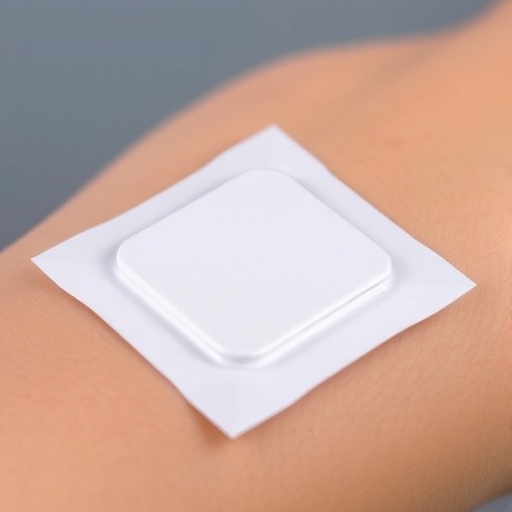In the intricate landscape of modern medical treatments, chronic wound management has always posed a significant challenge. Recent advancements in the field of nanotechnology and enzymatic applications have opened new doors, leading researchers to explore innovative solutions. Zhang, SJ., Xu, R., He, SB., and their colleagues have introduced a groundbreaking concept: nanozyme-driven multifunctional dressings that transcend conventional enzyme-like catalysis, potentially revolutionizing chronic wound treatment. Their research, encapsulated in the landmark study “Nanozyme-driven multifunctional dressings: moving beyond enzyme-like catalysis in chronic wound treatment,” published in the journal Military Medical Research, sheds critical light on this innovative approach designed to combat one of the most stubborn issues in healthcare today – chronic wounds.
Chronic wounds, which include diabetic ulcers, venous leg ulcers, and pressure sores, represent a significant healthcare burden. These conditions not only affect the quality of life for millions of individuals but also impose considerable costs on healthcare systems. The primary reason behind the persistence of these wounds lies in their complex healing processes that involve multiple biological mechanisms. Traditional treatments often fall short due to their inability to address the myriad of factors influencing wound healing. This complexity necessitates the need for advanced therapies that can simultaneously target several pathways involved in the healing process.
The innovative approach discussed in Zhang et al.’s research revolves around nanozymes—nanomaterials with enzyme-like properties that can catalyze biochemical reactions. Unlike natural enzymes, which can be expensive and sensitive to environmental conditions, nanozymes offer durability, stability, and ease of production at scale. This brings a significant advantage to their application in wound healing. Zhang and his team employed these nanozymes to create multifunctional dressings engineered to facilitate healing by mimicking the natural enzymatic functions that may be lacking in chronic wounds.
A key component of the proposed dressings is their ability to provide an antifungal and antibacterial environment, drastically reducing the risk of infection, which is a common complication in chronic wounds. Infections can severely delay the healing process, leading to worse patient outcomes. The multifunctional nature of these dressings allows them to integrate not only antimicrobial properties but also regenerative capabilities, addressing underlying issues such as inflammation commonly associated with chronic wounds.
The research dives deep into the mechanisms through which these nanozyme-driven dressings operate. By utilizing materials that can enhance the localized delivery of cytokines and growth factors, the dressings aim to actively promote tissue regeneration and repair. Interfering with the natural inflammatory response is a crucial aspect of managing chronic wounds, and the use of these advanced dressings can potentially fine-tune this process, leading to faster and more effective healing outcomes.
Zhang’s study highlights the critical role of superoxide dismutase (SOD) mimetics, a type of nanozyme, which can effectively reduce oxidative stress in wound sites. Oxidative stress is a well-known impediment to wound healing, often causing delayed responses to injury. By employing nanozymes that mimic SOD, the team has demonstrated an ability to modulate reactive oxygen species (ROS) levels, promoting an environment conducive to healing.
In addition to oxidative stress management, the dressings are designed to absorb excess exudate from wounds, maintaining the appropriate moisture balance that is vital for optimal healing. The balance of moisture in a wound environment is often overlooked, but it plays a pivotal role in cell migration and the formation of new tissue. Here, the multifunctional dressings present an added advantage, providing a controlled microenvironment necessary for various cellular processes to occur without interruption.
The study also emphasizes the biosafety of these novel dressings. Rigorous testing has shown that the components used in fabricating these dressings are biocompatible with human tissue, underscoring their potential for clinical applications. The safety profile is paramount in wound care, where adverse reactions can lead to increased morbidity and complicate recovery. The researchers assert that these dressings not only address the immediate needs of wound management but do so without introducing harmful foreign elements that could provoke undesirable responses from the body.
Importantly, the integration of smart technology into the design of these dressings opens the door for future applications. As healthcare continues to evolve, the ability to monitor wound conditions in real-time could significantly enhance patient outcomes. The next generation of multifunctional dressings could feature embedded sensors that provide feedback on parameters such as temperature, moisture levels, and even indicate the presence of pathogens.
The researchers posit that building upon their foundational work with nanozymes can lead to further innovations that may redefine the approach to chronic wound care. By constantly evolving the materials and technologies used in wound dressings, there exists the potential to create a dynamic treatment modality that adapts to the needs of individual patients.
The implications of this research extend beyond chronic wounds—its principles could also be harnessed to address a spectrum of conditions requiring extensive wound care. From surgical sites needing effective closure to traumatic injuries with complex healing requirements, the possibilities are vast. This versatility could lead to increased accessibility and effectiveness of wound care across a broad range of clinical settings.
As the world increasingly adopts nanotechnology into practical applications, the work of Zhang and his team underscores the importance of collaborative research efforts. Bridging the gap between basic research and practical medical advancements will be crucial in tackling enduring health challenges, such as chronic wound management. Future studies and trials will undoubtedly expand on these findings, exploring the potential of nanozymes in other contexts where enzymatic activities are critical.
The pursuit of innovation in the field of wound care is an ongoing journey, and research like that conducted by Zhang et al. is paving the way for a future where chronic wounds can be effectively managed, significantly improving patient outcomes. The application of such multifunctional dressings, driven by state-of-the-art nanotechnology, symbolizes a profound shift towards personalized medicine—targeting the unique needs of individuals facing challenges in wound healing with precision and efficacy.
As we reflect on the achievements presented in the study, it becomes clear that this new frontier in chronic wound treatment enables not only successful healing but also enhances the quality of life for patients, demonstrating the transformative power of integrating technology and medicine. With ongoing research and development, the aspirations to provide efficient, safe, and accessible treatments may soon become a reality.
Subject of Research: Nanozyme-driven multifunctional dressings for chronic wound treatment
Article Title: Nanozyme-driven multifunctional dressings: moving beyond enzyme-like catalysis in chronic wound treatment
Article References:
Zhang, SJ., Xu, R., He, SB. et al. Nanozyme-driven multifunctional dressings: moving beyond enzyme-like catalysis in chronic wound treatment.
Military Med Res 12, 27 (2025). https://doi.org/10.1186/s40779-025-00611-5
Image Credits: AI Generated
DOI: 10.1186/s40779-025-00611-5
Keywords: Nanozyme, multifunctional dressings, chronic wound treatment, enzymatic catalysis, wound healing, biocompatibility, real-time monitoring, oxidative stress, antimicrobial properties.
Tags: advanced therapies for wound healingdiabetic ulcer treatment advancementsenzymatic applications in wound carehealthcare burden of chronic woundsinnovative chronic wound management solutionsmultifunctional dressings in healthcarenanotechnology in medical treatmentsnanozyme dressings for chronic woundsovercoming chronic wound healing challengespressure sore treatment breakthroughsresearch on chronic wound carevenous leg ulcer care innovations





